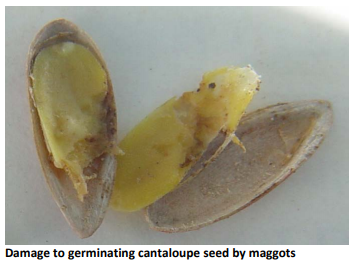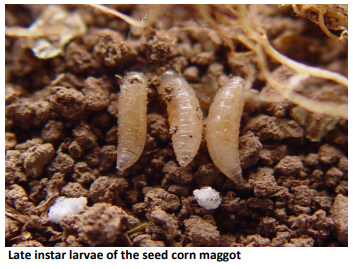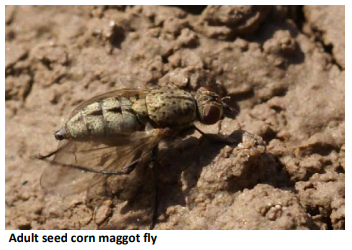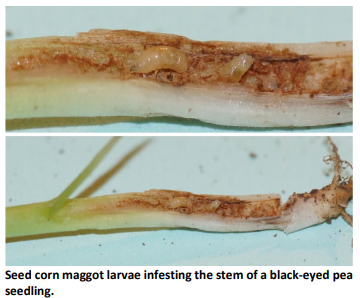Description: The seedcorn maggot, Delia platura, is a white, legless larva of a small light gray fly that attacks the planted seed of cantaloupes and watermelons during the spring. The adult is a grayish brown fly with a mid-dorsal strip on the abdomen.
Damage: The maggot attacks germinating seeds or transplants in the early spring when the soil is cool. Damage in spring melons usually occurs from maggots feeding of seeds and developing embryos before the plant emerges. The maggots bore into seeds as the seed coat splits, or feed on the emerging hypocotyl of developing plant. Seedlings with maggots can wilt and die within a few days. Watermelon transplants are also susceptible to maggots where they move from root balls into the stem.
In general, the adult flies will readily lay eggs in temperatures ranging from 50-80o F. The eggs are usually placed at the soil surface, singly or in a cluster of up to 10. Adults prefer to oviposit on germinating or decaying seeds, plant residue and organic fertilizer such as manure. Females prefer freshly turned soil egg laying, but will avoid laying eggs in dry soils. Larvae will develop at temperatures as low as 50°F, but optimal growth occurs at about 70°F where immature development can occur in less than 10 days.
The conditions that favor seed maggot infestations include high levels of decaying organic matter (produce plant residue) and cool wet weather. Cool weather can delay plant germination and emergence which favors the seed corn maggot. Manure, either composted or not, can also attract seed corn maggot flies to lay more eggs. Warm dry weather reduces the threat of continued seedcorn maggot damage. Under favorable growing conditions for melons (85-90 °F), little damage to germinating seed is likely to occur. The flies can also be attracted to the commercially prepared growing medium used to start melon transplants in the greenhouse.

Maggots can also be found attacking seeds of field crops such as black eyed peas, garbonzo beans, cotton and safflower. They can be particularly serious if there is a cold period that prevents quick germination of the seed. Maggots may overwinter as larvae in the soil or hatch from eggs laid in the spring. They usually have three-four generations per year, but only the first is usually economically significant in the desert.
Management: Fields with heavy-textured soil usually experience the worst problems with seed corn maggots. Once seed corn maggots larvae are found in planted or transplanted fields, there is no economic approach for their control. The following are suggestions for avoiding maggot problems:
• Incorporation of previous crop residues, by disking or plowing well in advance of planting (4-5 weeks) helps to reduce the attractiveness of the field to ovipositing flies. This also includes use of organic fertilizer and manures.
• Avoid, when possible, direct seeding or transplanting melons following cole crops, or lettuce fields that were lightly harvested and excessive plant residue remains in the field. This provides ovipositional sites for adults.
• Rapid seed germination greatly reduces the risk of infestation. Late season planting may avoid the early season infestation of this pest.
• An in-furrow spray application or transplant drench with an insecticide is a good method of control when conditions are ideal for maggot infestation.
• Bifenthrin (Capture LFR, Athena) applied as an infurrow sprays during planting has consistently shown good levels of control.
• Clothianidin (Belay), spinosad (Success, Entrust) and rynaxypyr (Coragen, Durivo) applied as infurrow sprays during planting have shown moderate-good level of control.
• Neonicotinioids (imidacloprid, thiamethoxam) applied 2-3" below the seed for aphid and whitefly control have not shown consistent performance in preventing maggots from damaging seeds.
• However, neonicotinoid seed treatments with this chemistry have been shown to provide better control of maggots in melons than their soil applied counterparts.



